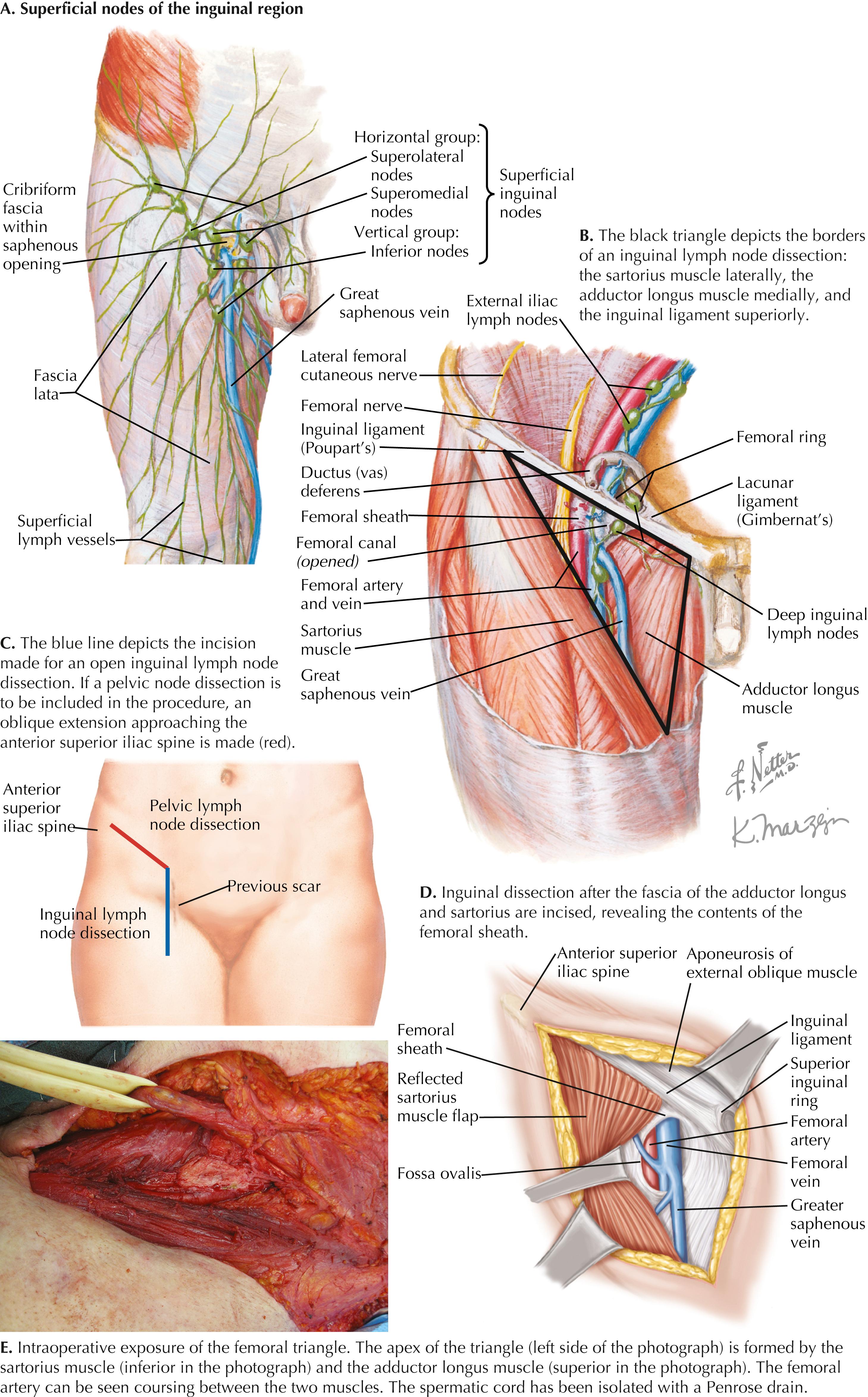Physical Address
304 North Cardinal St.
Dorchester Center, MA 02124
Inguinal lymph node dissection (ILND) is performed for therapeutic and staging purposes in neoplasms such as melanoma, penile cancer, and Merkel cell carcinoma and less commonly for sarcomas, squamous cell carcinoma, and vulvar, anal, and rectal cancers. Elective ILND is performed in T1b or greater penile cancers. In most diseases, the presence of clinically positive inguinal lymph nodes is an indication for ILND. In the absence of clinically positive nodes, sentinel lymphadenectomy is often offered to stage the lymph node basin. Historically, ILND was offered to patients with melanoma who have a positive sentinel node. More recently, prospective randomized data have demonstrated no improvement in melanoma-specific or overall survival in patients undergoing ILND for a positive sentinel node versus those undergoing ultrasound surveillance. Currently, ILND is often more selective and reserved for patients with significant sentinel node tumor burden and high-risk primary tumors.
Inguinal lymph node dissection is not without risks, with current rates of complications exceeding 50% in some series. Complications can include, but are not limited to, superficial and deep wound infections, wound dehiscence, seroma, lymphocele, hematoma, and lymphedema. A thorough understanding of the anatomy of the inguinal region is vital to minimize complications of this procedure. In the inguinal region, superficial nodes are those found superficial to the fascia lata proximally, whereas the deep nodes are defined as being deep to the fascia and adjacent to the femoral vessels ( Fig. 60.1A ). Inguinal lymph node dissection for oncologic indications involves removal of both levels of nodes.

In the operating room, the patient is placed in the supine position with the operative leg gently flexed, abducted, and externally rotated. Perioperative antibiotics should be administered. Pre- and postoperative evaluations by physical therapists specializing in lymphedema treatment and prevention are advocated, because the rate of lymphedema approaches 20%.
The borders of an inguinal lymph node dissection are defined by the sartorius muscle laterally, the adductor longus muscle medially, and the inguinal ligament superiorly. The sartorius courses medially across the thigh, creating a triangle containing lymphatic tissue ( Fig. 60.1B ). The lymph tissue surrounds the greater saphenous vein medially and extends laterally and superiorly toward the anterior superior iliac spine (ASIS). These are the primary nodes removed during an ILND.
Inguinal lymphadenectomy begins with an incision made along the long axis of the limb, starting at the inguinal ligament overlying the femoral vessels in the central portion of the triangle and extending below the groin crease ( Fig. 60.1C ). Dissection is carried down to the superficial fascia, or Camper’s fascia, as no lymphatics travel superficial to this fascial layer. Flaps are developed just deep to Camper’s fascia. The superficial lymphatic tissue 2 to 3 cm superior to the inguinal ligament is cleared by carrying the subcutaneous flaps laterally to an area just medial to the anterior superior iliac crest. Dissection is carried medially to expose the aponeurosis of the external oblique, the superficial inguinal ring, and the femoral sheath, containing the femoral artery, the femoral vein, and the femoral nerve. Care should be taken to identify the greater saphenous vein, which will be found superficial to the fascia of the medial thigh. The caudal dissection is begun at the adductor longus muscle, just below the inguinal ligament. The fascia of the adductor muscle and sartorius are incised. Dissection is continued inferiorly, along the medial border of the sartorius muscle and the lateral aspect of the adductor longus, to approach the apex of the femoral triangle ( Fig. 60.1D ). The femoral artery is then exposed and skeletonized superiorly, thus revealing the femoral vein. Distally the femoral vein lies posterior to the artery and then becomes more superficial and medial to the artery as one moves proximally in the femoral triangle ( Fig. 60.1E ). The areolar and fatty node-bearing tissue is reflected from the femoral vessels in the cephalad direction, and the vessels should be skeletonized. The femoral nerve and its branches should be identified and carefully protected. At the saphenofemoral junction, the saphenous vein can be ligated and divided or skeletonized and spared depending on involvement. Commonly there may be smaller separate venous branches going to the lymph node packet that must be ligated separately. The remaining attachments to the nodal packet are then divided and the specimen is removed. Coverage of the exposed femoral vessels is often needed after inguinal lymphadenectomy, which can be achieved using a sartorius muscle transposition. This maneuver involves detaching the sartorius from its tendinous insertion on the ASIS and rotating it medially over the femoral vessels. This flap is then sutured into place along the inguinal ligament. Care should be taken to ensure that its medial blood supply remains intact. Placement of a drain in the surgical bed, which should exit the skin lateral to the incision, helps in the prevention and management of postoperative lymphocele and seroma. Early ambulation and appropriate pharmacologic prophylaxis are essential to decrease the incidence of postoperative deep vein thrombosis.
Become a Clinical Tree membership for Full access and enjoy Unlimited articles
If you are a member. Log in here